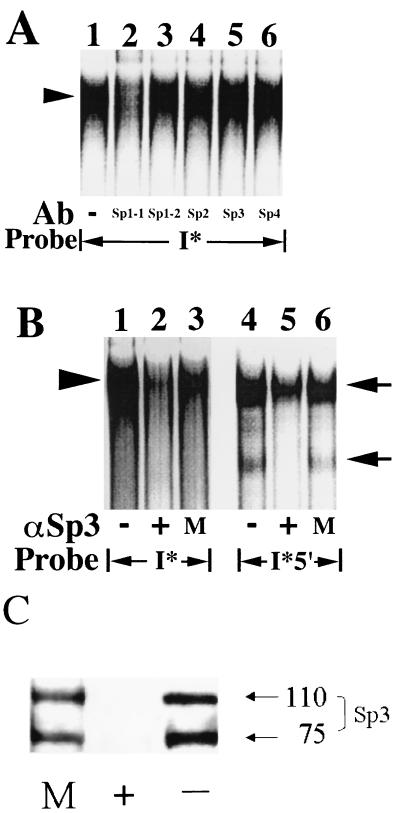FIG. 7.
The I* element-binding complex contains the Sp3 transcription factor and an Sp1-like protein. (A) Nuclear extracts (12.5 μg) prepared from quiescent fibroblasts were used in mobility shift assays along with the radiolabeled double-stranded oligonucleotide probe shown. The sequence of the probe is given in Fig. 6G. Antibodies (Ab) specific for individual members of the Sp1 family of transcription factors (2 μg) were added where indicated. The Sp1-1 and Sp1-2 antibodies are as described in the legend to Fig. 6F. The arrowhead on the left highlights the predominant complex that binds specifically to the I* probe. Free probe is not shown. No complexes were observed with the probe alone in the absence of extract (data not shown). (B) Nuclear extracts (12.5 μg) prepared from quiescent fibroblasts were used in mobility shift assays along with the radiolabeled double-stranded oligonucleotide probes shown. The sequences of the probes are given in Fig. 6G. Extracts were immunodepleted initially with anti-Sp3 antibodies (+), mock immunodepleted with rabbit immunoglobulin G (M), or not treated (−). The arrowhead on the left highlights the predominant complex that binds specifically to the I* probe. The arrows on the right highlight the positions of the two complexes that bind specifically to the 5′ subregion (I*5′) probe. Free probe is not shown. No complexes were observed with the probes alone in the absence of extract (data not shown). (C) Immunoblot of an aliquot (30 μg) of the extracts used for panel B with the anti-Sp3 antibody. The designations +, M, and − are as described for panel B. Molecular sizes are given in kilodaltons.

